pH Kit for Soil Testing: Ultimate Guide for Accurate Results
Have you ever poured your heart into your garden, only to watch your plants struggle despite your best efforts? The key to flourishing plants is hidden beneath the surface—in the soil’s pH. Whether you’re an experienced gardener or just starting out, grasping your soil’s pH level is essential for robust plant growth.
In this guide, you’ll discover everything you need to know about pH kits for soil testing. From the top 5 kits on the market to step-by-step instructions on how to use them, this article will equip you with the knowledge to test your soil like a pro. Let’s dive in and unlock the full potential of your garden!
Table of Contents
Why Soil pH Testing is Crucial for Your Garden
Your soil’s pH level determines how well your plants can absorb nutrients. If the pH is too high or too low, essential nutrients like nitrogen, phosphorus, and potassium become locked in the soil, unavailable to your plants. This can lead to stunted growth, yellow leaves, and even plant death.
The majority of plants flourish in a slightly acidic to neutral pH range of 6.0 to 7.0. However, some plants, like blueberries, prefer more acidic soil, while others, like asparagus, thrive in alkaline conditions. Testing your soil’s pH ensures you can create the ideal environment for your plants to flourish.
Types of Soil pH Test Kits: Which One is Right for You?
Not all soil test kits are created equal. Here’s a detailed breakdown of the most common types to help you choose the best one for your needs:
Chemical Test Kits
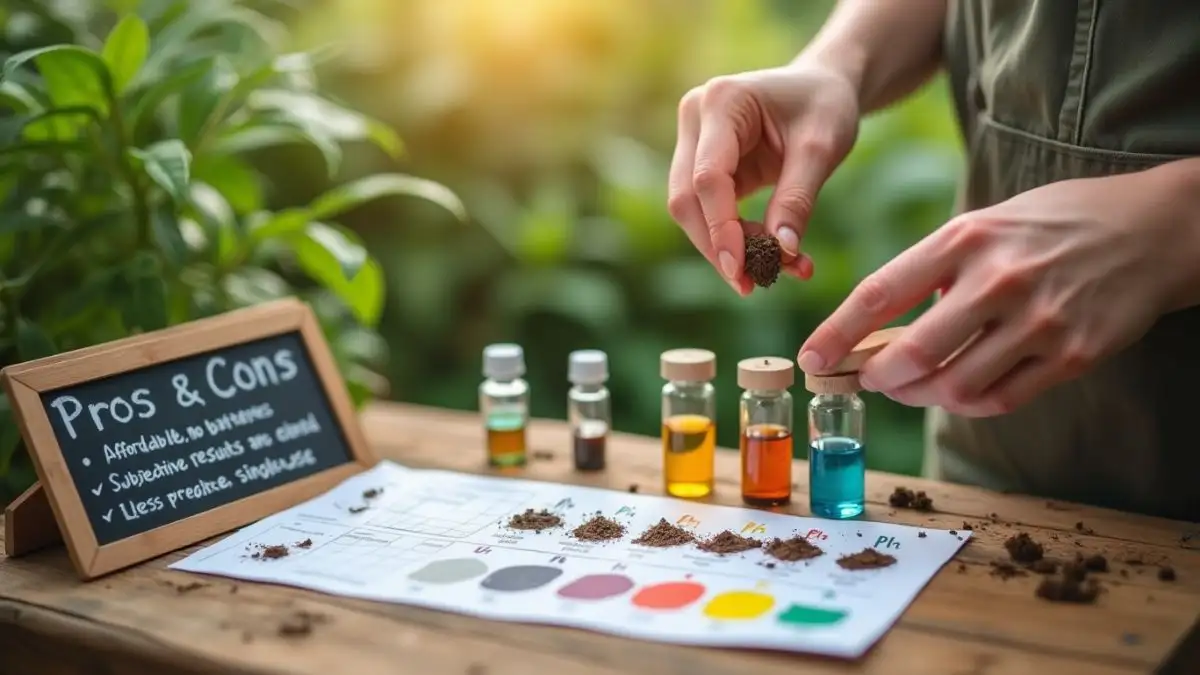
Chemical test kits are one of the most popular options for home gardeners. They typically include a set of vials, chemical solutions, and a color chart.
- How They Work:
You mix a small soil sample with the provided solution, shake it, and let it settle. The solution changes color based on the soil’s pH, which you then compare to the chart. - Pros:
- Affordable and widely available.
- No batteries or electricity required.
- Easy to use for beginners.
- Cons:
- Results can be subjective, depending on how well you interpret the color.
- Less precise than digital testers.
- Typically single-use, so you’ll need to buy refills.
- Best For: Gardeners who want a quick, budget-friendly option for occasional testing.
Digital pH Testers
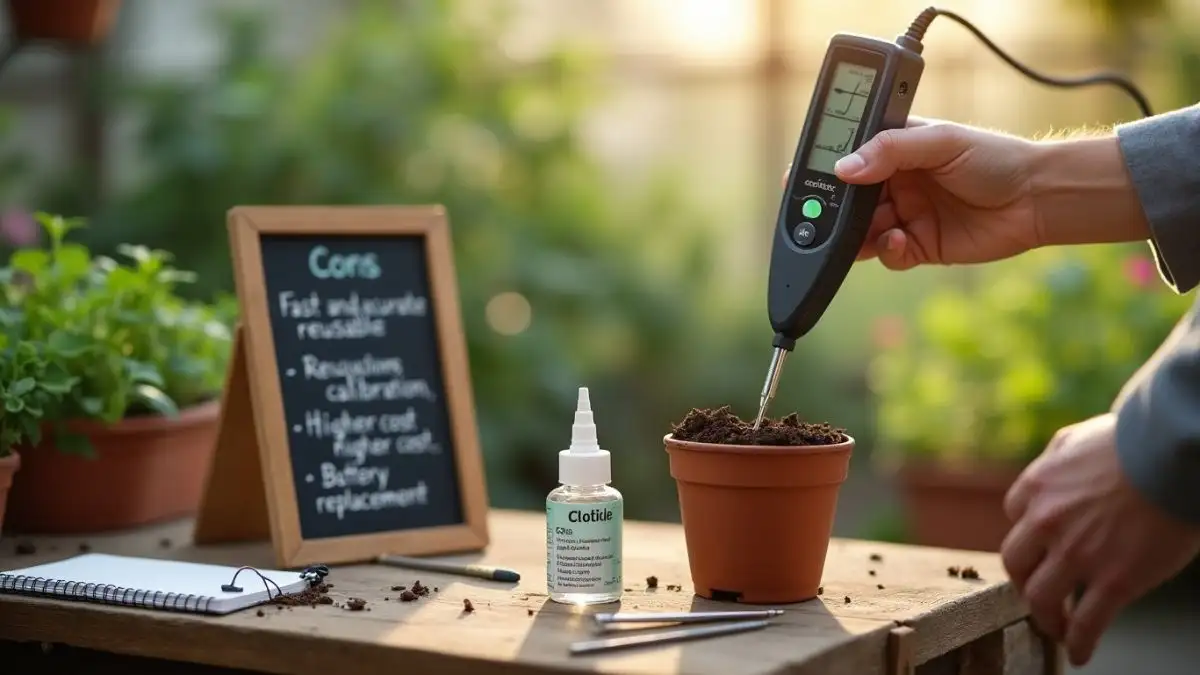
Digital pH testers, also known as pH soil testers, are electronic devices that provide instant readings.
- How They Work:
Insert the probe into the soil, and the device displays the pH level on a digital screen. Some advanced models also measure moisture and light levels. - Pros:
- Fast and accurate results.
- Reusable and long-lasting with proper care.
- Some models offer additional features like moisture and light sensors.
- Cons:
- Requires regular calibration for accurate readings.
- Higher upfront cost compared to chemical kits.
- Batteries may need replacement over time.
- Best For: Serious gardeners or professionals who need precise, frequent measurements.
Test Strips
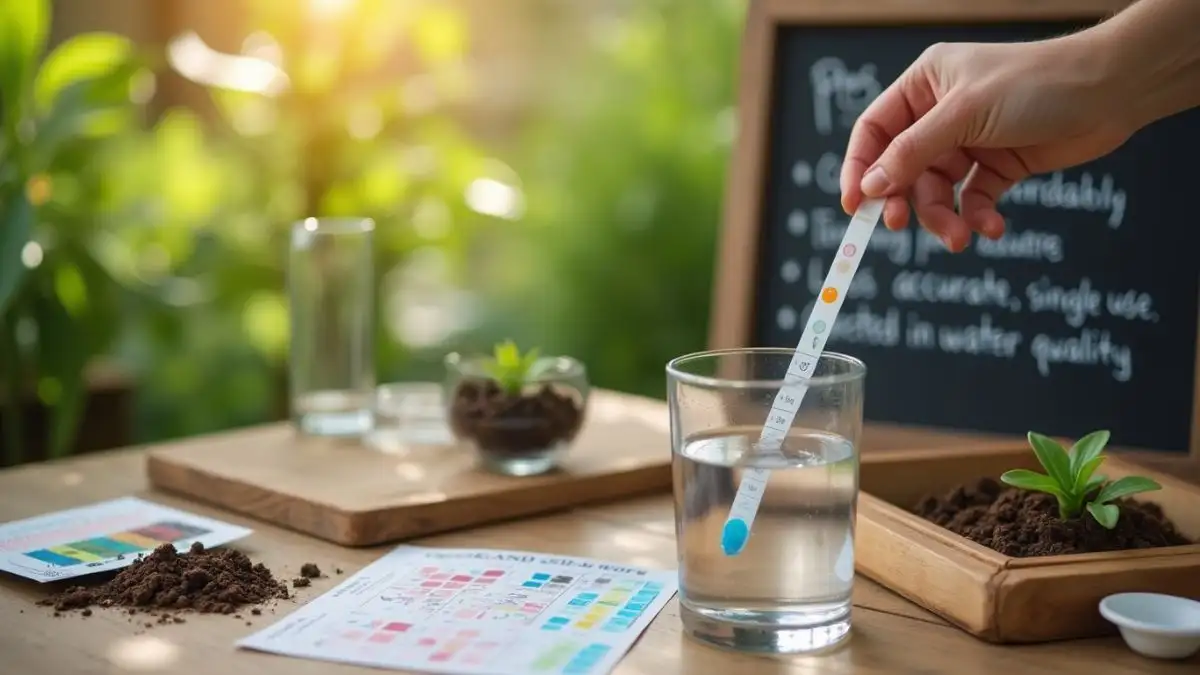
Test strips offer a straightforward and affordable method to check soil pH.
- How They Work:
Mix soil with distilled water, dip the strip into the mixture, and compare the color change to a provided chart. - Pros:
- Quick and easy to use.
- Very affordable.
- Portable and convenient for on-the-go testing.
- Cons:
- Less accurate than chemical or digital options.
- Single-use, so you’ll need to buy more strips.
- Results can be affected by water quality.
- Best For: Casual gardeners who want a no-fuss, budget-friendly option.
Laboratory Tests
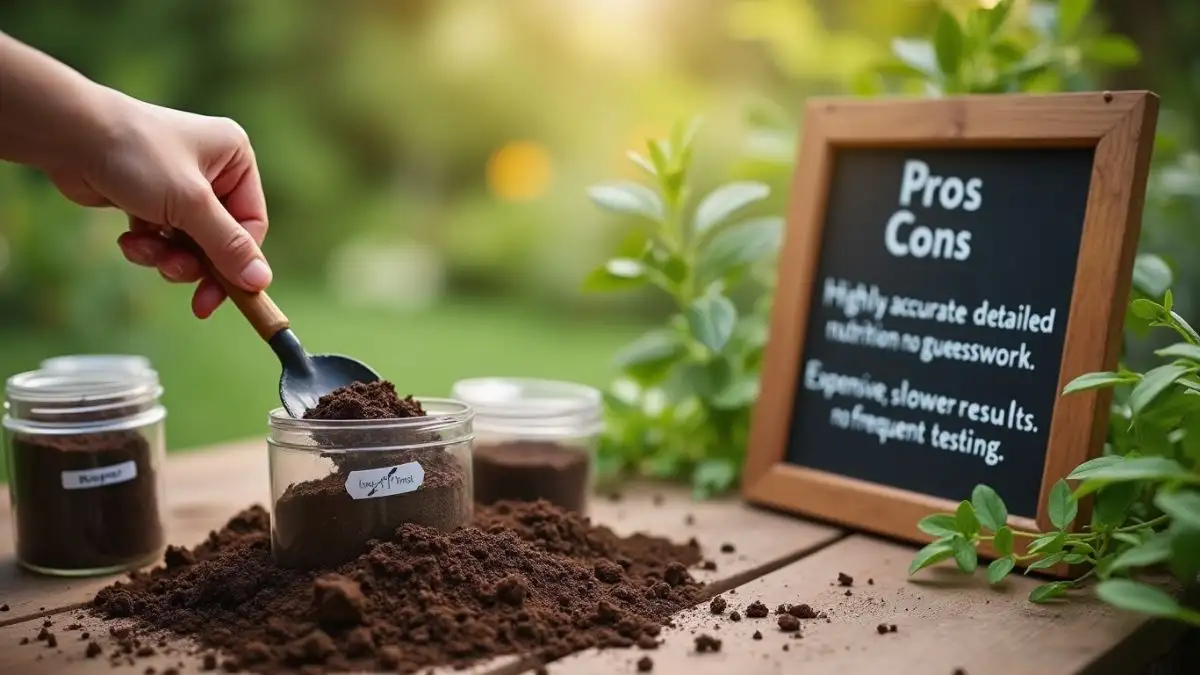
For the most accurate and comprehensive results, you can send soil samples to a professional lab.
- How They Work:
Collect soil samples from your garden, mail them to the lab, and wait for a detailed report. - Pros:
- Highly accurate and reliable.
- Provides detailed information about nutrient levels and soil composition.
- No guesswork involved.
- Cons:
- Expensive compared to DIY kits.
- Results take longer to obtain (typically 1–2 weeks).
- Not practical for frequent testing.
- Best For: Gardeners who want a one-time, in-depth analysis of their soil.
How to Use a pH Kit for Soil Testing: Step-by-Step Guide
Testing your soil’s pH is simpler than you may imagine. Adhere to these steps for precise results:
- Collect Soil Samples:
- Use a trowel to collect soil from multiple areas of your garden. Aim for a depth of 4–6 inches.
- Prepare the Sample:
- Remove debris like rocks and roots. Mix the soil with distilled water if your kit requires it.
- Test the Soil:
- Follow the instructions for your specific kit. For chemical kits, add the solution and observe the color change. For digital testers, insert the probe and wait for the reading.
- Interpret Results:
- Compare your results to the ideal pH range for your plants.
- Adjust pH if Necessary:
- Apply lime to increase pH or sulfur to decrease pH. Retest after a few weeks to ensure the desired level is achieved.
5 Top pH Kits for Soil Testing in 2025
Here’s an in-depth look at the top 5 soil pH test kits to consider in 2025:
1. Luster Leaf 1601
- Type: Chemical
- Accuracy: High
- Price: $15
- Best For: Budget-conscious gardeners.
Why It’s Great:
The Luster Leaf 1601 is a reliable and affordable option for home gardeners. It includes everything you need to test your soil’s pH, including a color chart and easy-to-follow instructions.
Pros:
- Affordable and widely available.
- No batteries or electricity required.
- Easy to use for beginners.
Cons:
- Results can be subjective.
- Less precise than digital testers.
2. Sonkir Soil pH Meter
- Type: Digital
- Accuracy: Medium
- Price: $12
- Best For: Quick, easy readings.
Why It’s Great:
The Sonkir Soil pH Meter is a budget-friendly digital tester that provides instant results. It’s perfect for gardeners who want a no-fuss option.
Pros:
- Fast and easy to use.
- No batteries required.
- Compact and portable.
Cons:
- Requires calibration for accurate readings.
- Less durable than higher-end models.
3. Garden Tutor pH Strips
- Type: Test Strips
- Accuracy: Low
- Price: $10
- Best For: Occasional testing.
Why It’s Great:
These pH strips are a simple and inexpensive way to test your soil. They’re ideal for casual gardeners who don’t need frequent or highly accurate results.
Pros:
- Quick and easy to use.
- Very affordable.
- Portable and convenient.
Cons:
- Less accurate than other options.
- Single-use, so you’ll need to buy more strips.
4. Bluelab Soil pH Pen
- Type: Digital
- Accuracy: High
- Price: $100
- Best For: Professional gardeners.
Why It’s Great:
The Bluelab Soil pH Pen is a top-of-the-line digital tester that offers exceptional accuracy and durability. It’s perfect for serious gardeners or professionals.
Pros:
- Highly accurate and reliable.
- Reusable and long-lasting.
- Easy to calibrate.
Cons:
- Expensive compared to other options.
- Requires batteries.
5. Rapitest 1835
- Type: Chemical
- Accuracy: Medium
- Price: $20
- Best For: Reliable, mid-range option.
Why It’s Great:
The Rapitest 1835 is a trusted chemical test kit that strikes a balance between affordability and accuracy. It’s a great choice for gardeners who want reliable results without breaking the bank.
Pros:
- Affordable and easy to use.
- No batteries required.
- Comes with a detailed instruction manual.
Cons:
- Results can be subjective.
- Less precise than digital testers.
Tips for Maintaining Optimal Soil pH
Once you’ve tested your soil, maintaining the right pH is key to long-term garden health. Here’s how:
- Check your soil at least annually, ideally before the planting season begins.
- Use organic matter like compost to stabilize pH levels naturally.
- Avoid over-fertilizing, as synthetic fertilizers can alter soil pH.
- Rotate crops to avoid nutrient depletion and pH imbalances.
Common Mistakes to Avoid When Testing Soil pH
Even with the best soil pH test kit, mistakes can happen. Avoid these common pitfalls:
- Testing Only One Area: Soil pH can vary across your garden. Test multiple spots for accurate results.
- Ignoring Instructions: Each kit has specific guidelines. Follow them carefully to avoid errors.
- Not Retesting: After adjusting pH, wait a few weeks and retest to ensure the desired level is achieved.
- Using Tap Water: Distilled water is recommended for accurate readings.
How to Adjust Soil pH Naturally
If your soil’s pH is off, don’t worry—it’s fixable. Here’s how to adjust it naturally:
- To Raise pH: Add agricultural lime, wood ash, or crushed eggshells.
- To Lower pH: Use elemental sulfur, peat moss, or pine needles.
For example, if your soil has a pH of 5.0, apply 5–10 pounds of lime per 100 square feet to raise it to 6.5.
Benefits of Using a Digital pH Soil Tester
Digital pH soil testers offer several advantages:
- Instant results without waiting for color changes.
- Reusable and long-lasting with proper care.
- Some models measure moisture and light levels, providing additional data for gardeners.
DIY Soil pH Testing: Is It Reliable?
While DIY methods like using vinegar and baking soda can give a rough estimate, they’re not as reliable as a pH kit for soil testing. For consistent results, invest in a quality kit.
Conclusion
Testing your soil’s pH is one of the most important steps you can take to ensure a thriving garden. With the right soil pH test kit, you can unlock your garden’s full potential and enjoy healthier, more vibrant plants.
By understanding the different types of kits available—chemical, digital, test strips, and lab tests—you can choose the one that best suits your needs. Whether you’re a casual gardener or a professional, regular soil testing will help you maintain optimal pH levels and create the perfect environment for your plants to flourish.
Ready to get started? Choose one of the recommended kits and test your soil today. Your garden will thank you!
FAQ Section
- What is the best pH kit for soil testing?
- The best kit depends on your needs. For accuracy, go with a digital tester like the Bluelab Soil pH Pen. For affordability, try the Luster Leaf 1601.
- How often should I test my soil pH?
- Check your soil at least annually, or prior to planting new crops.
- Can I use a pH soil tester for potted plants?
- Yes, most pH testers work well for both garden soil and potted plants.
- What is the ideal pH for most plants?
- The majority of plants flourish in a pH range of 6.0 to 7.0.
- How do I adjust soil pH if it’s too high or too low?
- Use lime to raise pH or sulfur to lower pH, and retest after a few weeks.
- Are digital pH testers better than chemical kits?
- Digital testers are faster and more accurate, but chemical kits are affordable and reliable for most home gardeners.
- Can I test soil pH without a kit?
- DIY methods like vinegar and baking soda can give a rough estimate, but they are not as reliable as a pH kit for soil testing.
- What happens if my soil pH is too acidic?
- Acidic soil (pH below 6.0) can cause nutrient deficiencies. Add lime to raise the pH.
- What happens if my soil pH is too alkaline?
- Alkaline soil (pH above 7.5) can restrict nutrient absorption. Incorporate sulfur or organic material to reduce the pH.
- Can I reuse a soil pH test kit?
- Chemical kits and test strips are typically single-use, whereas digital testers can be reused.
This detailed guide offers all the information you need about soil pH testing and the top kits to utilize. By following these tips and recommendations, you’ll be well on your way to creating a thriving, healthy garden. Happy gardening!


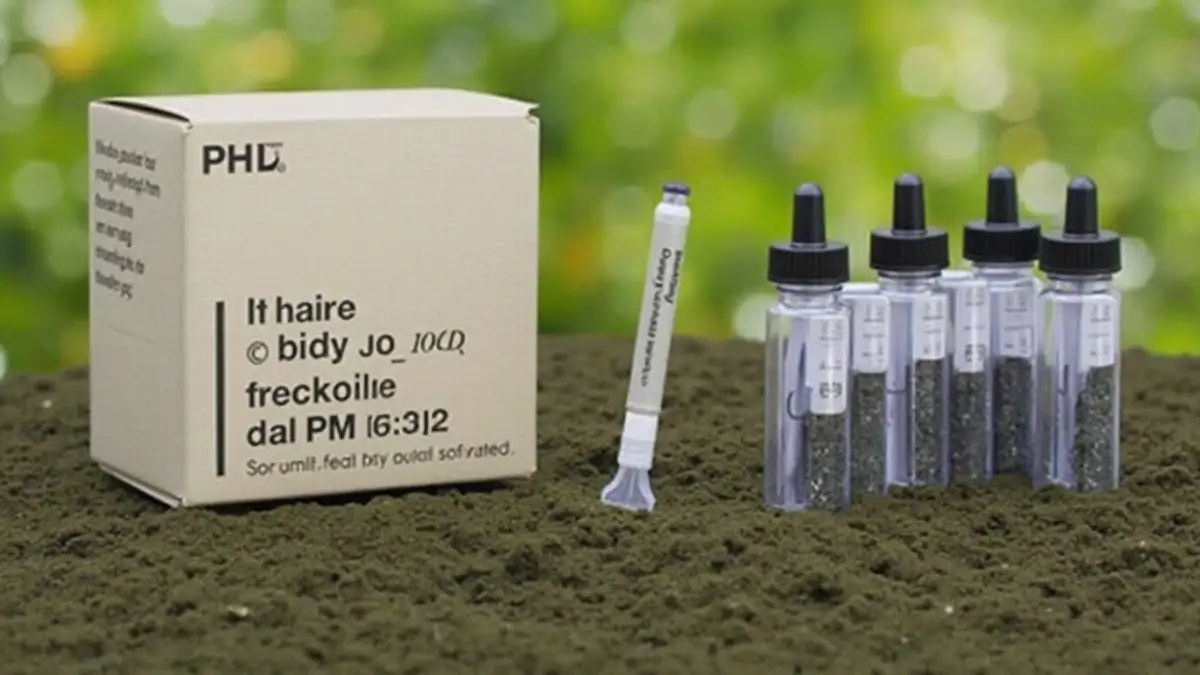
2 thoughts on “5 Best pH Kit for Soil Testing: Ultimate Guide for Accurate Results”